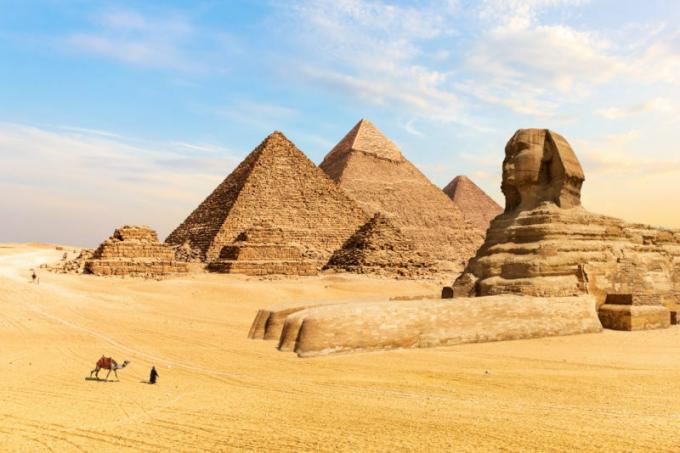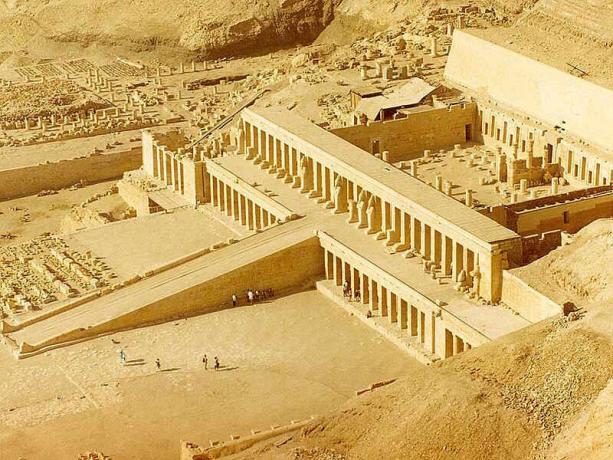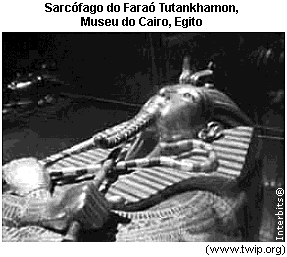O Pharaoh was the ruler in Ancient Egypt, figure of connection between the earthly plane and the divine and between the territories of Egypt itself. His government was theocratic and his power was political, religious, legal, administrative and military. Throughout its history, Egypt has had 31 dynasties of pharaohs. Among the most remembered pharaohs and queens, the following stand out: Menes, Amenhotep IV, Tutankhamun, Ramses II, Hatshepsut Thutmose III and Queen Cleopatra.
Read too: After all, what is the story of the ten plagues of Egypt?
Summary about pharaoh
- Pharaoh was the name given to the ruler in Ancient Egypt.
- Egypt has had 31 dynasties of pharaohs throughout its history.
- The first pharaoh of Ancient Egypt was Menes, who unified the names of Upper and Lower Egypt around the year 3000 BC. W.
- The pharaoh was seen as a “living god”, his power was based on religiosity and was reinforced through the belief in the immortality of the soul.
- The pharaoh used architecture and art to show the grandeur of his power.
- He controlled the use of water, land, agricultural production and determined the construction of public works, such as temples, palaces, sculptures and irrigation canals.
- The pharaohs Menes, Amenophis IV, Tutankhamun, Ramses II, Hatshepsut, Thutmose III and Queen Cleopatra are some of the best known in the history of Ancient Egypt.
Who were the pharaohs?
Pharaoh was the authority that governed Ancient Egypt, his power was political, religious, legal, administrative and military. He was seen as the incarnation of the god Horus on Earth, being considered a “living god”, and his word had the force of law. Owner of all Egyptian territory, he governed the population with the help of the nobility and public officials such as advisors, priests and scribes.
The Pharaoh had theocratic government, i.e. government whose power emanates from a deity. Its symbols were the scepter, which represented power, and the double crown, which showed the union between Upper and Lower Egypt.
History of the pharaohs
Egypt had 31 dynasties of pharaohs throughout its history, in three historical periods: Old Kingdom (3200 a. W. to 2300 a. C), Middle Kingdom (2055 a. W. to 1650 a. C.) and New Empire (1500 to 1085 B.C.). Their names were unified around the year 3000 BC. C, under the government of Menes, who is considered by several historians to be the first pharaoh. It is important to mention that some historical documents attribute the name Narmer (Greek translation) to Menes.
The pharaoh was a connecting figure between the earthly and divine planes, and between the territories of Egypt itself. Among the most remembered pharaohs and pharaoh queens in history, the following stand out: Pharaoh Amenhotep IV and his wife Nefertiti; the boy pharaoh Tutankhamun; Pharaoh Ramses II; Queen Hatshepsut, exalted as the daughter of the god Amun; Pharaoh Thutmose III, known as the “Napoleon of Ancient Egypt”; and Queen Cleopatra.
See too: Anubis — Egyptian deity of the dead and mummification
How powerful are the pharaohs?
The power of the pharaohs was based on religion, since they were seen as living gods. In Ancient Egypt, religiosity was present in various aspects of daily life. With the polytheistic belief in gods that could take on anthropomorphic, zoomorphic and anthropozoomorphic aspects, The Egyptians also perceived the pharaoh as the son of Ra and as the incarnation of the god Horus, gods related to the Sun.
The pharaohs used the architecture and art to show the grandeur and strength of his power. In this regard, several funerary monuments were built, such as mastabas and pyramids, as well as religious temples, sculptures and paintings.
Among the constructions carried out, the most famous are the pyramids of Cheops, Chephren and Menquerinos, the first of which is considered one of the Seven Wonders of the Ancient World. In addition to the pyramids, the Sphinx of Giza, built during the rule of Pharaoh Khafre (2575-2465 a. W.), is also a world-renowned monument.

Writing was also used as a way of recording the history of the pharaohs., decoration of monuments and demonstration of power, the best known being hieroglyphic, hieratic and demotic writing.
What was the role of the pharaohs?
The Pharaoh exercised his role as head of state and religious leader, in a theocratic monarchy. Considered a living god, he concentrated political, economic, social, administrative, legal and military powers in his hands.
He also controlled the use of water, land, agricultural production and determined the construction of public works, such as temples, palaces, sculptures and irrigation canals. Furthermore, he received the taxes paid by the population, a fact that enabled his wealth and power to increase.
What was life like for the pharaohs?
The Pharaoh had a luxurious life, who could have two or more palaces filled with scepter furniture covered with a thin layer of gold, received ceremonies in his honor, his food was plentiful, he dressed in linen clothes, adorned herself with gold jewelry and precious stones, made use of oils and he could have several wives, however only the first would receive the title of queen.
His power was reinforced through religiosity and the belief in the immortality of the soul. Aiming to preserve the body, the pharaoh's mummification process was much more elaborate than that of other social strata, accompanied by funerary constructions, such as the pyramids.

As a way of immortalizing their deeds and paying homage to deities, the pharaohs ordered the construction of large temples. Hieroglyphic writing and art were used to represent political, social, cultural and economic aspects of their lives, as well as to pay homage to them. When the pharaoh went out in public, he used a litter so that it could be identified by the population.
Who are the most famous pharaohs in history?
→ Amenhotep IV and his wife Nefertiti
One of the most remembered Egyptian rulers in history is the pharaoh of the 18th dynasty, Amenhotep IV (1388-1335 BC). C.), which Tried to establish monotheism in Ancient Egypt, through the imposition of the god Aten (solar disc) as the only god, changing his name to Akhenaton (he who worships Aten).
He ordered the construction of temples in several cities Egyptians and in Karnak, honoring his wife Nefertiti with four colossal statues. Furthermore, Amenhotep was the father of Tutankhamun, the boy pharaoh, who managed to become even more famous than his father in current historiography.
→ Tutankhamun

Tutankhamun's fame is not due to his great achievements in Antiquity, as died at just 18 years of age, having spent little time in government. In his tomb, in the Valley of the Kings, English researcher Howard Carter and his team found several treasures, such as such as vases, chariots, biers, sculptures, the sarcophagus and the pharaoh's throne carved in wood and covered with gold. The discovery made the pharaoh's name known.
→ Ramses II
Pharaoh Ramses II, who reigned between 1279 a. W. and 1213 a. W., Her government was marked by the construction of great monuments, such as the Abu Simbel temple. In 1968, during the construction of the Aswan dam in Egypt, the Abu Simbel temple, which is approximately 20 meters high, high, had its rocks cut into large blocks and was transferred to another location above the water level of the dam. Its transfer was supported by UNESCO and international cooperation.
→ Queen Hatshepsut
Queen Hatshepsut, exalted as daughter of the god Amun, who reigned from 1511 BC. W. to 1480 a. C, she became known and remembered through the construction of the mortuary temple of Deir el-Bahari, Western Thebes, close to the regions of the Valley of the Kings and Valley of the Queens.

→ Thutmose III
Pharaoh Thutmose III, son of Thutmose II and step-nephew of Queen Hatshepsut, ruled Egypt from 1479 BC. W. and 1425 a. W., It is known as "the Napoleon of Ancient Egypt”, due to the numerous military victories during her reign.
→ Queen Cleopatra
Among the most prominent rulers of Ancient Egypt, one woman stood out: Queen Cleopatra. Daughter of Ptolemy XII, Cleopatra ruled between the years of 51 BC. W. and 30 a. C., and stayed known for her wisdom, political skill and beauty. Furthermore, her trajectory was also marked by her involvement with the Roman rulers Julius Caesar, of the first Roman triumvirate, and Marco Antônio, of the second triumvirate, as well as his tragic end through suicide.
Video lesson about Cleopatra
Curiosities about the pharaohs
- Images of Queen Hatshepsut found in the temple and tomb complex in Deir el-Bahari, Luxor, Egypt, show that the queen suffered attempts to erase her memory in ancient times.
- In 1898, British researcher James Quibell found the Narmer Palette, a 63 cm object. Its relief probably represents the unification of Upper and Lower Egypt by its first pharaoh, Ménes.
- In 1968, during the construction of the Aswan dam in Egypt, the Abu Simbel temple, built during the rule of Pharaoh Ramses II, it was moved to another location above the water level of the dam. Its transfer was supported by UNESCO and international cooperation.
- The mummy of Pharaoh Thutmose III, considered the “Napoleon of Egypt”, was found with pharaoh mummies in a hiding place in Deir el-Bahari, at the end of the 19th century.
- Decades after the opening of Pharaoh Tutankhamun's tomb in 1922, the fungus Aspergillus niger, which rested alongside the pharaoh's remains, was found on the death certificates of the archaeological team that made up the discovery.
- The expression “pharaonic work”, referring to the works carried out by the pharaohs, is present in our culture in a pejorative way to designate architecture. grandiose and expensive measures at the expense of public coffers and linked to the idea of demonstrating the power of rulers, but which have little use practice.
- The pleated clothes worn by pharaohs and queens influence the world of fashion to this day.
- Cleopatra used skin treatments using clay, milk baths and makeup.
Know more: Did the Romans also worship multiple gods?
Solved exercises about pharaoh
1. (Uepa 2015) The polytheism present in the religious cosmology of Ancient Egypt resulted from the combination of deities worshiped in the various nome (peasant communities) subject to the authority of the pharaoh since the Ancient Empire. The organization and hierarchy of the pantheon of Egyptian deities were shaken throughout the succession of pharaohs due to:
a) political disputes between the pharaoh and the priestly class, the elite controlling the temples and bureaucratic administration of the Empire.
b) religious divergences between the nome, a permanent factor of political and religious instability in the Empire.
c) constant invasions of foreign peoples in Egypt such as Hyksos and Assyrians, who imposed their religious beliefs on the native populations.
d) disparity between the anthropomorphic religion of the nobles and the zoomorphic beliefs of the peasants.
e) penetration of Hebrew monotheism in Egypt, when their status as servants of the State was established in the 13th century BC. W.
Response: [A]
Comment: In Ancient Egypt, the population was polytheistic and the pharaoh was considered the incarnation of the god Horus. Throughout history, there have been several conflicts between pharaohs and priests, due to political and religious disputes.
2. (Uftm 2012) In January 2011, newspapers reported that protests against the Egyptian government could have an effect very serious collateral: the destruction or damage of various relics, works and archaeological sites of ancient civilization Egyptian. According to news agencies, there were several attempts to loot the Cairo Museum. In one of them, individuals broke just over a dozen statues and decapitated two mummies, recently identified as grandmothers of Pharaoh Tutankhamun. Some looters seemed to be looking only for gold.

Regarding archaeological material from Ancient Egypt, it is correct to state that
a) its destruction would affect Egypt's economy, but would not have serious consequences for science and history, which have already studied this material.
b) a large part of it was destroyed by the Egyptians themselves in Antiquity, as a strategy to protect the secrets of their culture from invaders.
c) it was one of the causes of protests against the government, which paid large sums to recover objects held by European countries.
d) allowed us to understand the importance of funeral rituals, as attested by the sarcophagi from the Valley of the Kings.
e) has great artistic value and confirmed what was already known about the ancient Egyptians through written documents.
Response: [D]
Comment: Archaeological discoveries in the Valley of the Kings region were fundamental to a better understanding of the political, cultural and social past of Ancient Egypt.
Image credits
[1]Francisco Xavier Diaz/ Shutterstock
[2] Wikimedia Commons
Sources
ARAÚJO, Emanuel. Poor divine pharaohs. History Texts,Magazine of the Postgraduate Program in History at UnB., v. 4, no. 2, p. 05-29, 1996.
RUE, Joseph Jobson from A.; PILETTI, Nelson. All the history. 4 ed. São Paulo: Ática, 1996.
BOULOS JÚNIOR, Alfredo. History, Society & Citizenship. 3rd Ed. São Paulo: FTD, 2015,
CABRAL, Jessica. Thutmose III: “the Napoleon of Ancient Egypt”, In: Cultural Highlight, Ancient Egypt. Egyptian and Rosicrucian Museums Tutankhamun. Available in: https://museuegipcioerosacruz.org.br/tutmes-iii-o-napoleao-do-egito-antigo/
DOS SANTOS PIRES, Rafael. God, Father, Intermediary: the role of Amon in Hatshepsut's speech. Mare Nostrum, v. 11, no. 2, p. 1-29, 2020.
FRAGA, Olivia. What was the life of a pharaoh like? Super interesting, 22 Mar. 2013. Available in: https://super.abril.com.br/mundo-estranho/como-era-a-vida-de-um-farao#goog_rewarded
PANAZZO, Silvia; VAZ, Maria Luisa. Journeys-History.– History 6th year. 2nd Ed. São Paulo: Saraiva, 2012.
PROENÇA, Grace. Art history. São Paulo: Ática, 2012.
VICENTINO, Cláudio; VICENTINO, José; DORIGO, GIANPAOLO. History. Single volume. São Paulo: Scipione, 2014.
WAGNER, Gustavo Peretti; DA SILVA, Lucas Antonio. Counting Contagions. Tessituras: Journal of Anthropology and Archeology, v. 8, no. 1, p. 120-127, 2020.


